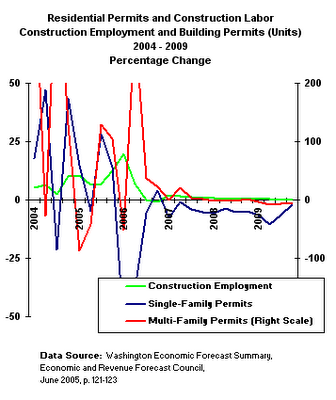
It is not so much that the lines of the future look improbably pacific compared to the radical agitation of the past. This is a function of using actual observations to inform the past and projections based on macroeconomic movement (i.e., ignorance) to inform the future. And it is not the seeming contradiction in the lines, where sometimes employment goes up as the other two go down, or vice versa. This has to do with the lag between permit and construction.
What troubled me was that the change in employment somehow stays above the changes in the projected permit activity. The difference may look tiny on the chart, but the green line stays higher. Construction firms don't have you on the payroll unless you're working. What gives? If anything, it should be lower.
I asked my friend (... I like him, he tolerates me ...) in construction trades. [Now this gets interesting, so follow along to the end.]
Commercial construction, says he.
I said, of course, "What commercial construction?"
The Olympics is drawing construction labor from north of Seattle. Snohomish County has broken ground on a $4.1 billion sewage treatment plant. Sound Transit is all over the light rail in Seattle, and that's going to go on for awhile. DOT projects, including the second Tacoma Narrows bridge, are going full steam, and Olympia and the Port of Tacoma have just signed off on a study of a rail coordination facility in the South Sound.
Public works! That's what commercial construction! The Keynesian in me loves it.
That is very interesting, but here is the really good part:
Skilled construction work is in demand and will be in demand over the next half dozen years. The kind of work that is done on these complex, long-term projects. If you need a career and don't mind union benefits, union wage scales, being reliable and being motivated, get hold of one of the union apprenticeship programs. This is not $8 per hour framing that is over at the end of the season. It is skilled work, and it is not particularly seasonal, and there are openings. The union programs are the best, says my friend, and biggest.
Unskilled or semi-skilled workers are going to be looking around for other jobs after residential building tapers off, and it likely mean significant dislocation and stress for some of us, both newcomers and others. But skilled workers are at a premium. Some projects go unstarted because there aren't enough skilled workers for the top layer to graduate into site supervision. That is, the tools are needed, so upward mobility is retarded.
So, clink! To public works! Good employment. Better infrastructure for everybody. And support under demand for local businesses. Your tax dollars at work. Clink!
NOTE: Anyone who wants to explore apprenticeship opportunities in Washington should start at the Labor & Industries website www.lni.wa.gov that shows a full listing of the programs and application procedures.




